UNDER CONSTRUCTION
Please read the Introduction to the Documents Section
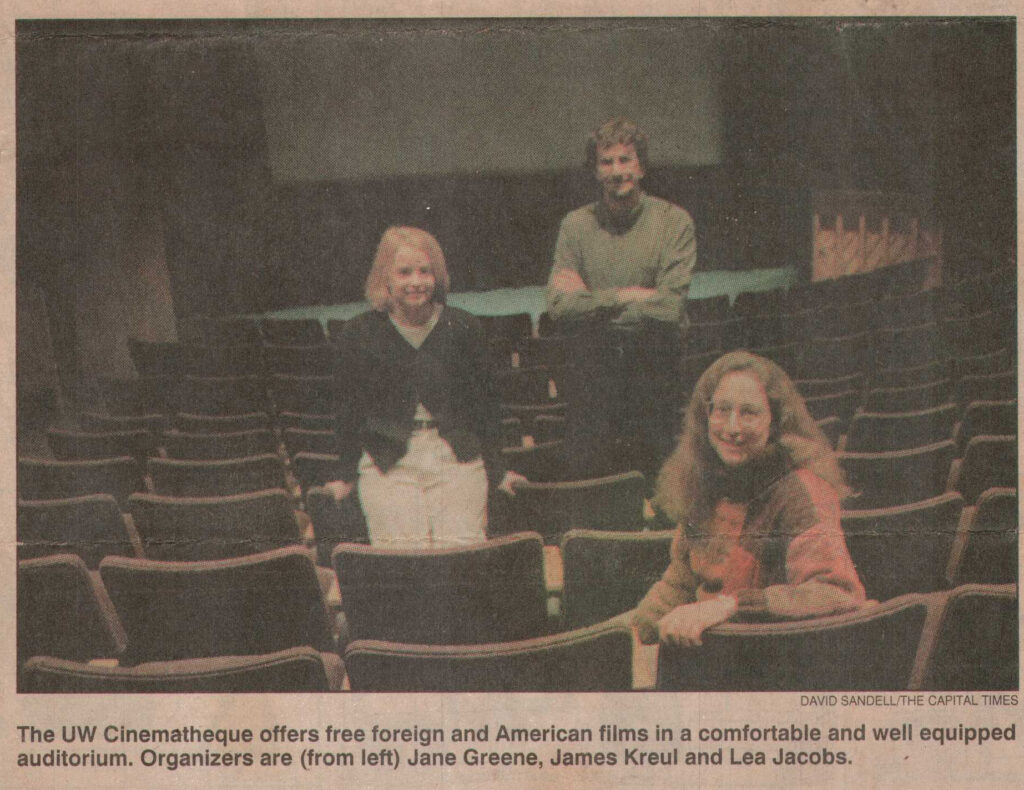
The UW-Cinematheque exists to this day, of course, and it is an essential resource in Madison thanks to current staff Jim Healy, Mike King, Ben Reiser, and many others. It remains the cornerstone of the Wisconsin Film Festival. You can find current schedule information at cinema.wisc.edu.
This page (still under construction) will focus on documents related to the early years of the UW-Cinematheque, beginning with my appointment as the first project assistant for the program in 1998.
Communication Arts professor and film scholar Lea Jacobs wrote grant proposals and secured the resources not only to launch the UW Cinematheque, but also to fund a graduate project assistantship to coordinate its programming. I will always be grateful for her confidence in me when I was appointed the first Cinematheque P.A. While I was often the person quoted in the media in the early days of the Cinematheque (because that was part of my new job, and I had established press relationships though Madison Film Forum), Lea is the one to thank for the vision and the creation of the UW-Cinematheque. She did not get sufficient credit in early Cinematheque press coverage. The picture above features Lea Jacobs, Jane Greene, and myself promoting the Spring 1999 season in The Capital Times, January 20, 1999.

Lea and other professors in Com Arts worked very hard to secure the resources to project 35mm film in 4070 Vilas Hall for film classes as well as public screenings.
Early versions of the 35mm projection system in 4070 Vilas Hall had a Eprad MUT (reel Make Up Table) system,1 meaning that the film reels had to be spliced together on one large reel to go through one projector.
In order to secure archival prints, which would be central to Cinematheque programming, Jacobs and other professors like David Bordwell secured the resources for a “changeover” system, adding another projector to change back and forth between reels. This eliminated the need to take head and tail leaders off the prints and often introducing new splices, which archives frown upon.
“For the kind of film you’re going to see [in 4070 Vilas] it’s the best theater in town,” Lea concluded in a Daily Cardinal article about the renovations. That is a claim that the Cinematheque continues to make 25 years later.
The text of the first poster declares the initial mission of the Cinematheque, and it highlights the renovations to 4070 Vilas Hall that made the Cinematheque possible.
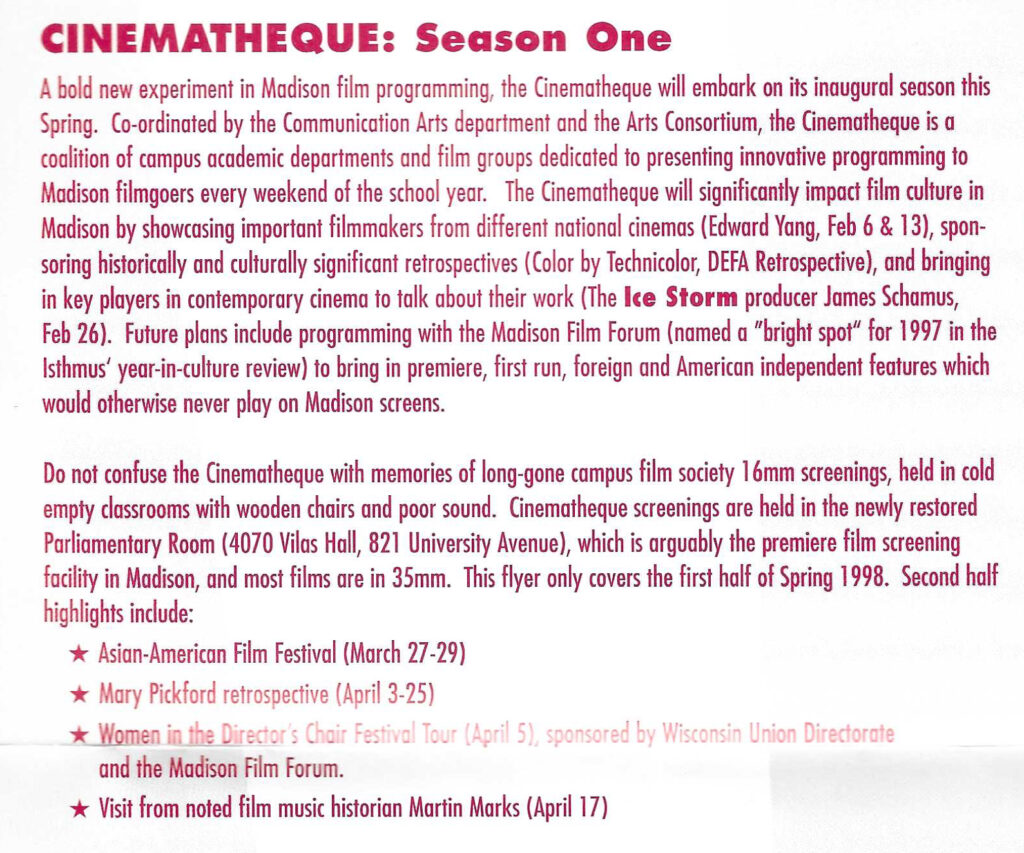
It is worth teasing out a few details in the mission statement. First, the UW-Cinematheque was initially conceived as a coalition of departments and campus groups (like Madison Film Forum) who were already doing their own film programming. The Cinematheque provided an opportunity not only to screen films in 35mm, but also to streamline scheduling and promotion efforts so that different series did not end up counter-programming each other. Coordinated programming also meant that budgets for different series at the UW-Cinematheque could be spread across different academic departments and campus film groups until a budget for the Cinematheque itself could be secured. A grant proposal for Fall 1998, which summarizes the lessons learned in the Spring, includes the following passage to emphasize the benefits of building a coalition.
Many departments have organized film screenings in the past. The advantages for all these groups in co-operating within the framework of the Cinematheque have recently become apparent. It helps secure access for all to the best viewing site on campus: the newly refurbished 4070 Vilas Hall, which is heavily used for both classes and outside screenings. It provides a means of advance planning so that film series do not conflict with one another. It orchestrates a consistent program, every Friday and Saturday night while the University is in session, in order to build an audience for its unusual film fare. It co-ordinates publicity from a central site, producing a brochure which describes the film offerings for the semester and maintaining contact with the local press.
Application for Funding for the Madison Cinematheque for Fall Semester 1998
In the Cinematheque Spring 1998 season, the German Department sponsored “East Germany: DEFA Retrospective” (DEFA was the state-owned film studio in East Germany). The Asian American Studies Program sponsored the “Asian American Film Series.” Marc Silberman from the German Department and Hemant Shah, director of the Asian American Studies program each provided a letter of support for the Fall 1998 Cinematheque grant proposal.
Second, the frequent references to the Arts Consortium in the initial Cinematheque poster foreshadow important developments leading up to the Wisconsin Film Festival. The Arts Consortium was established in 1975 to coordinate arts activities and arts units on campus. All of the events on the first Cinematheque calendar were co-sponsored by the Arts Consortium. The chair of the Arts Consortium at this time was Communication Arts professor and film industry scholar Tino Balio, who had also served as the director of the Wisconsin Center for Film and Theater Research.
The consortium spent three years studying how campus arts departments and programs might be strengthened and unified. The UW-Cinematheque had a parallel goal of building a coalition of departments and film groups.
By the end of 1998, Chancellor David Ward established the Arts Institute to supersede the Arts Consortium, with Tino Balio serving as executive director. “The type of collaboration we want to encourage is exemplified by the UW-Madison Cinematheque, a coalition of campus departments and Madison film groups,” Balio explained in the press release announcing the Arts Institute. “The institute will look forward to supporting similar collaborative ventures in the future.”
The creation of the UW-Cinematheque and the Arts Institute in 1998 were crucial developments in the story of the inaugural Wisconsin Film Festival in 1999. In September 1998, Tino Balio produced a memo titled, “Status Report on the Great Wisconsin Film Fest ’99,” writing “Only the dates of the festival are set; everything else in this report is subject to change.” More on this in future updates to the Wisconsin Film Festival documents page.
The Arts Institute became the administrative home of the Wisconsin Film Festival, while the Festival programming was spearheaded by the UW-Cinematheque (with partners at WUD Film) and the Department of Communication Arts. The Arts Institute became a campus division in 2013, and was renamed Division of the Arts in 2018. The Wisconsin Film Festival officially moved its administrative home from the Arts Institute to the Department of Communication Arts in 2021.
1998: Three Calendars and Branding
Once plans were in place to start the UW-Cinematheque in January 1998, the first printed calendar had to be put together relatively quickly. The first semester was split up into two printed calendars in order to get the first half printed quickly while we confirmed titles and dates for the second half. (I need to do some digging to find the name of the UW design unit that helped us with the first few posters.)
The first calendar covered January through March, 1998. Design wise, the first two posters were pretty bare bones. But content wise, the calendar included a pretty great lineup of films, starting with Singin’ in the Rain (1952) and series of restored 35mm prints Technicolor classics from Warner Brothers and MGM. Graduate student Scott Higgins, now a professor at Wesleyan University, was researching Technicolor history, which eventually led to his book Harnessing the Technicolor Rainbow: Color Design in the 1930s (University of Texas Press, 2009).
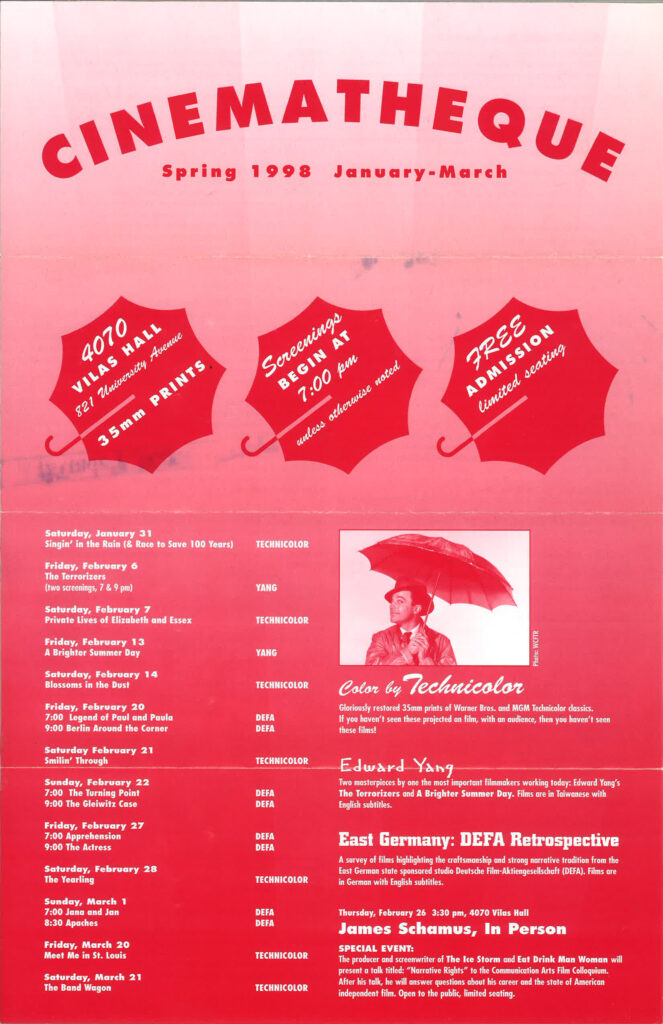
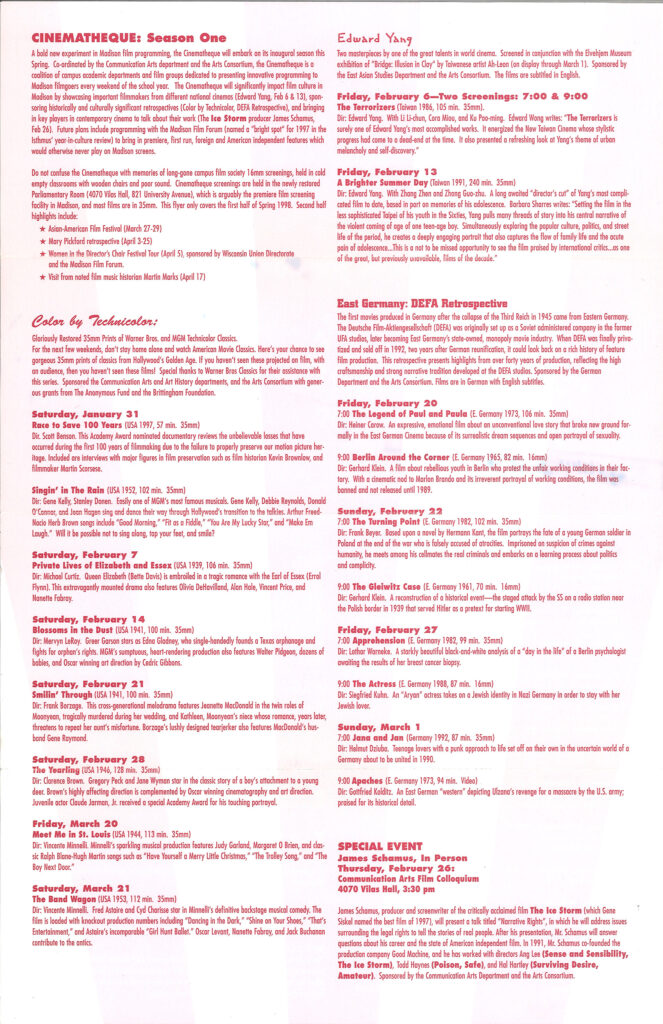
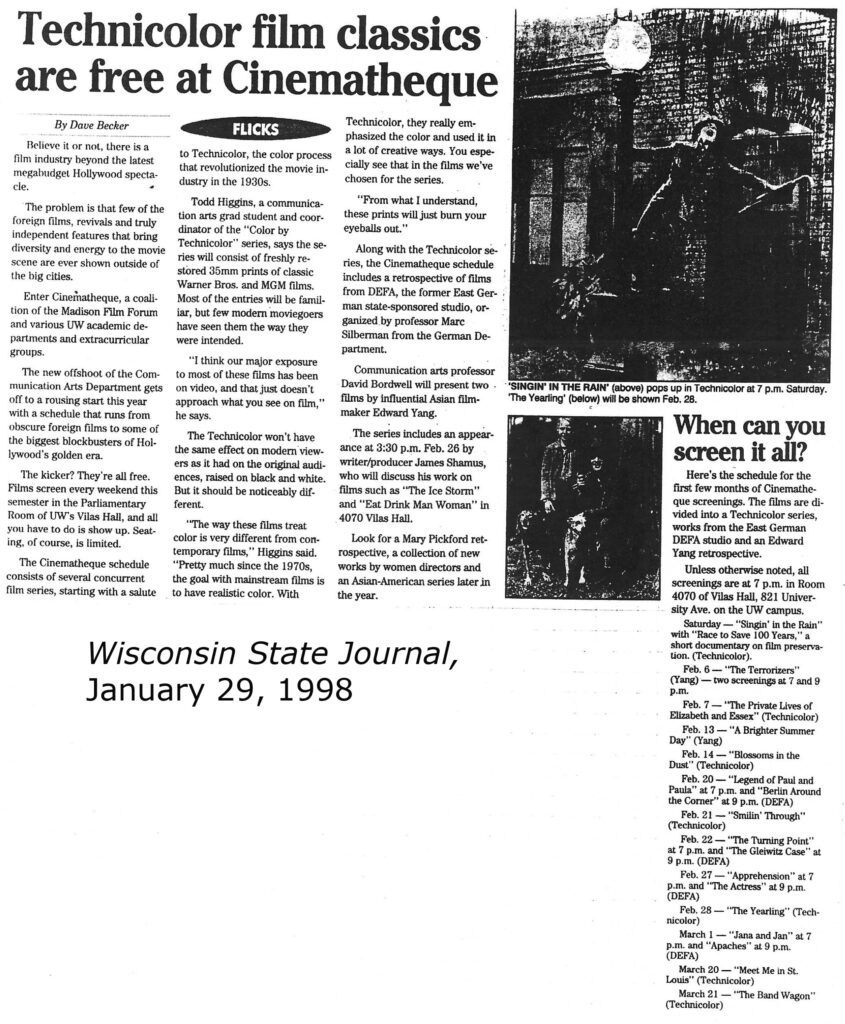
The debut of the Cinematheque garnered quite a bit of positive press. But from the start, branding and project messaging was difficult. In January 29, 1998 Wisconsin State Journal, Dave Becker called the Cinematheque “a coalition of the Madison Film Forum and various UW academic departments and extra curricular groups.” That’s almost correct, but not quite. The phrasing unfortunately implied that Madison Film Forum was leading the coalition. The press wanted to know “who, what, where when,” and the “who” in this instance was a challenge to state concisely.
As I discuss in the Madison Film Forum documents page, Isthmus had started to give full-review coverage of some Madison Film Forum screenings in 1996. This set the stage for Cinematheque coverage in Isthmus in 1998.

In a Cinematheque grant proposal for 1999 funding, Jacobs wrote, “Isthmus has become . . . central to our efforts to draw an audience. The paper gives a major review to each series, and helps to launch it.” Isthmus‘s Cinematheque reviews and series overviews in 1998, by Kent Williams, included (in screening order, but I’m uncertain of publication dates at the moment):
- A Brighter Summer Day (Edward Yang, Taiwan, 1991)
- The Terrorizers (Edward Yang, Taiwan, 1986)
- Mary Pickford: The First Superstar (series preview)
- Happy Together (Wong Kar-wai, Hong Kong, 1997)
- Underground (Emir Kusturica, Serbia, 1995)
- Taste of Cherry (Abbas Kiarostami, Iran, 1997)
- Warhol in Madison (series preview, and separate short The Chelsea Girls review)
Happy Together, Underground, and Taste of Cherry were Madison Film Forum screenings, and the first two were co-sponsored by Wisconsin Union Directorate International Film Committee. (Isthmus reviews of other campus films in 1998 included Jon Moritsugu’s Fame Whore, in advance of his in-person WUD Film screening at the Memorial Union Play Circle.)
The schedule poster for the second half of Spring 1998 addressed something that was missing from the first poster: it was not obvious that the Cinematheque was a program of the University of Wisconsin-Madison. The school’s name was added to the top fourth of the poster. There was still some internal discussion of what to call the Cinematheque, with the concern over University branding in mind. As noted above, one early grant proposal called it the Madison Cinematheque. Eventually, UW-Madison Cinematheque or UW-Cinematheque were the names used most frequently by the press.
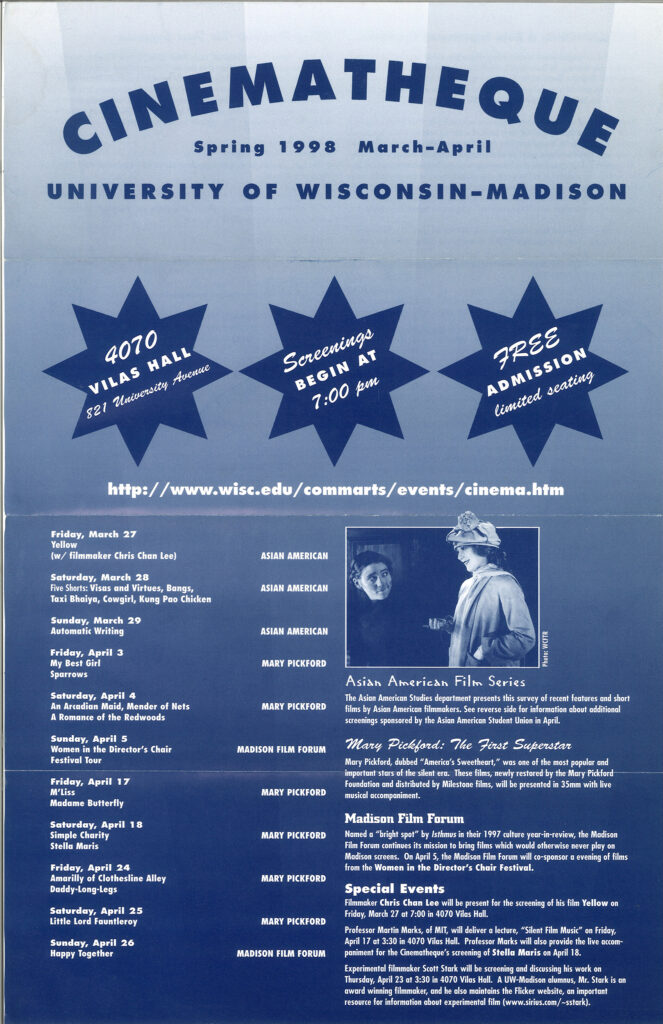
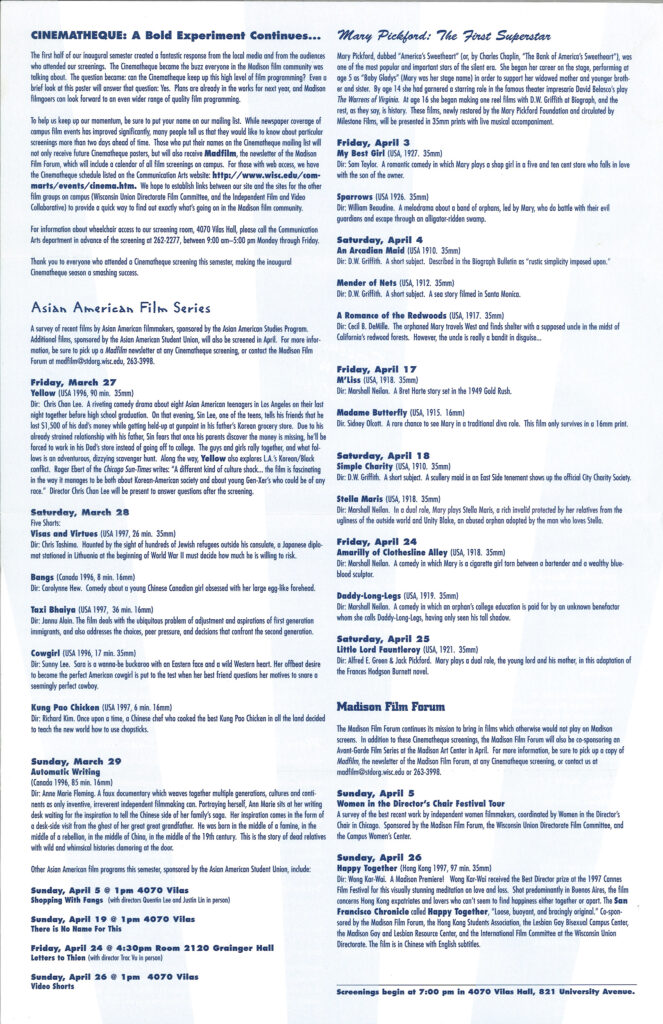
With more time over the summer to work on the design for Fall 1998, the UW design unit that we worked with came up with the basic look of the calendar poster that became the template for about 10 years (with modifications in dimensions, folding patterns, and the logo). The basic template was a large, attention grabbing image and a list of dates and titles on the front, and film descriptions with some additional images on the back.
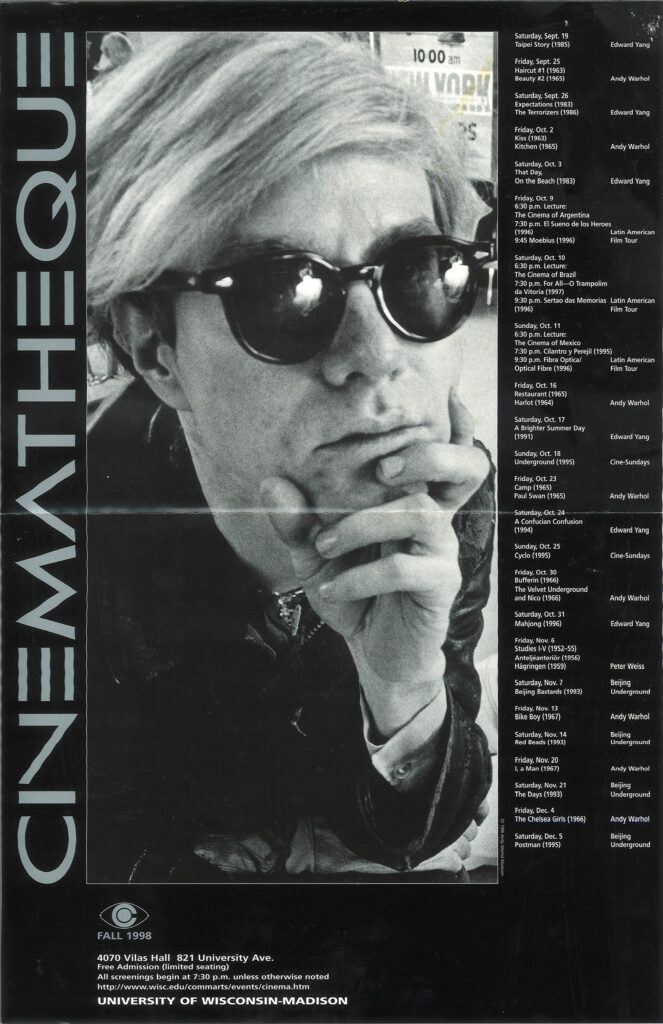
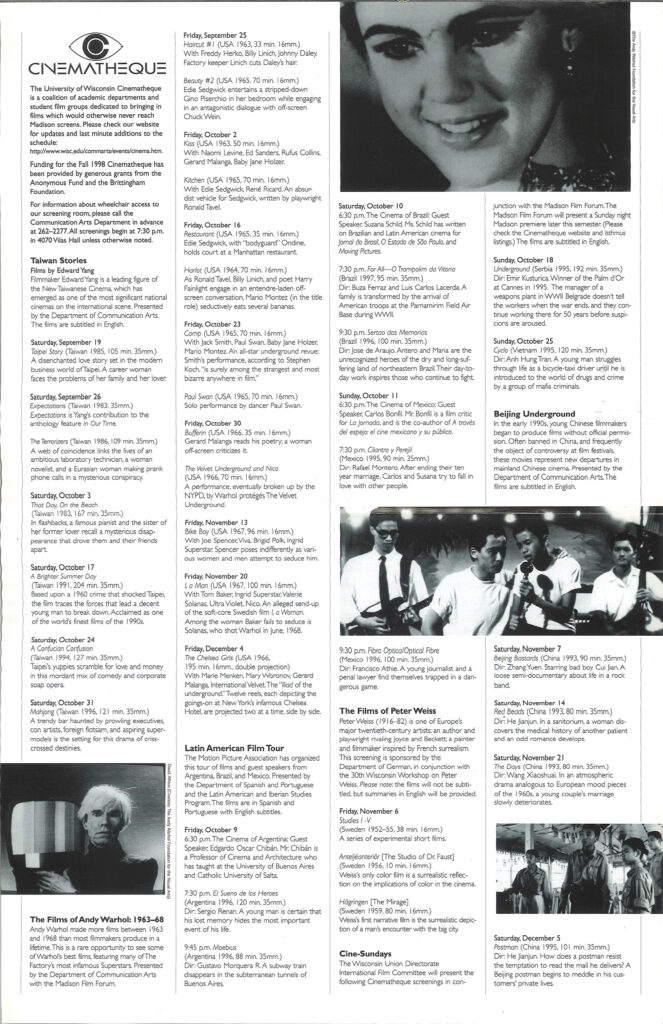
Obviously, with Warhol films as the showcase series, I have a lot to say about Fall 1998 that will have to wait for a future update to this page.
Part of my job was to collect images to be used on the poster, write copy for the film synopses, and deliver the the images and text to the designers. I attempted to streamline the verbiage of the Cinematheque mission by using what we had been stating for years was the mission of the Madison Film Forum: “to bring in films which otherwise would not play on Madison screens.” You will see that phrase pop up many times in documents and press coverage for the Madison Film Forum, and you can see it in the Madison Film Forum section of the blue Spring 1998 calendar.

Without any in-depth discussion with anyone about it, I started using the phrase to describe the Cinematheque mission starting with the Fall 1998 calendar. The coalition aspect of the Cinematheque mission was still there, but “bring in films which otherwise would not play on Madison screens” provided an easily repeatable phrase that succinctly summarized our mission.
Like the poster template, that phrase remained part of the Cinematheque identity for at least 10 years. On the left is the introduction to the Fall 1998 program details, on the right is the introduction to the program details on the Fall 2008 poster, which included a screening of Singin’ in the Rain to commemorate the 10th anniversary of the Cinematheque.
The history of the phrase is not a particularly profound detail. But it does help illustrate a degree of continuity from the Madison Film Forum starting in 1995 and the Cinematheque starting in 1998.
There is a lot more to say about 1998, and more documents to share. But until I have an opportunity for updates and revisions, I want to end with the Isthmus review of arts scene in Madison in 1998, published on December 25.

Of course it was great to have the Cinematheque mentioned in the opening paragraphs as a significant development in 1998. And it is easy to forget that Marcus Theaters had begun its art house experiment with the Westgate Art Theaters. But other details are worth paying attention to in order to trace important developments that would influence the Wisconsin Film Festival in 1999 and 2000.
The biggest arts story in 1998 was Jerome Frautschi’s $50 million dollar gift for the creation of a downtown arts district. What was less clear at the time was that Overture Project President George Austin was not interested in finding a role for cinema within plans for the proposed district (see “Full-time cinema still not in the cards for arts district,” The Capital Times, April 6, 2000). Also less clear from the press release announcing the creation of the Arts Institute (discussed above) was that the AI was formed in part to create a unified voice for campus arts in relation to the proposed downtown arts district. Hovering in the middle of those two stories was the uncertain future of the Orpheum Theater, across the street from what would become the Overture Center. How do these three stories relate to the early years of the Wisconsin Film Festival?
Stay tuned and find out.
- Thank you to Erik Gunneson for supplying this detail. ↩︎

